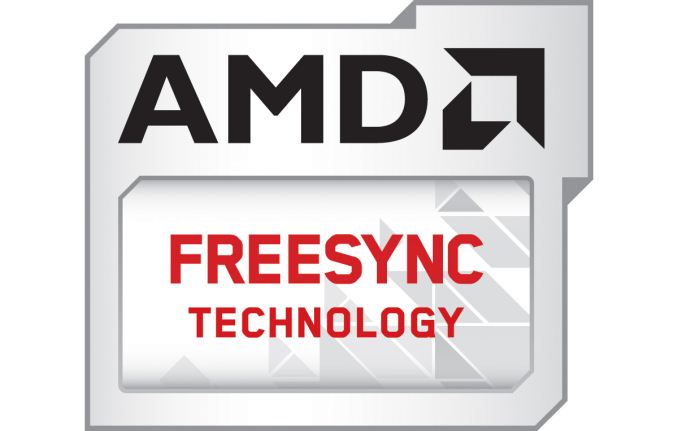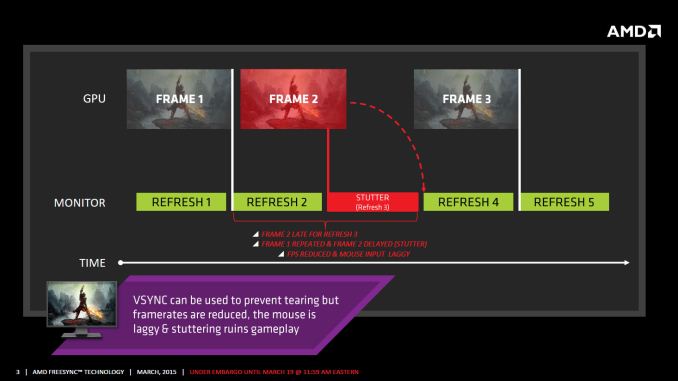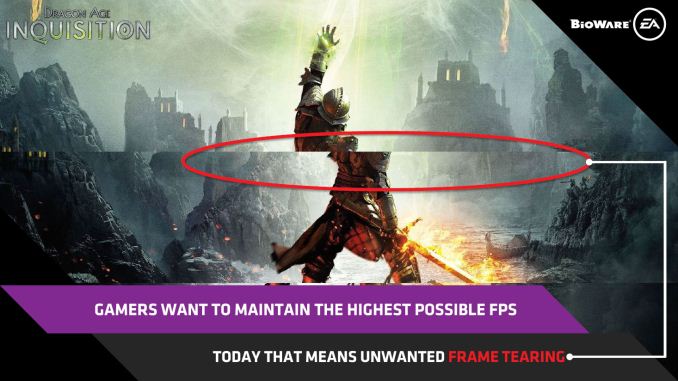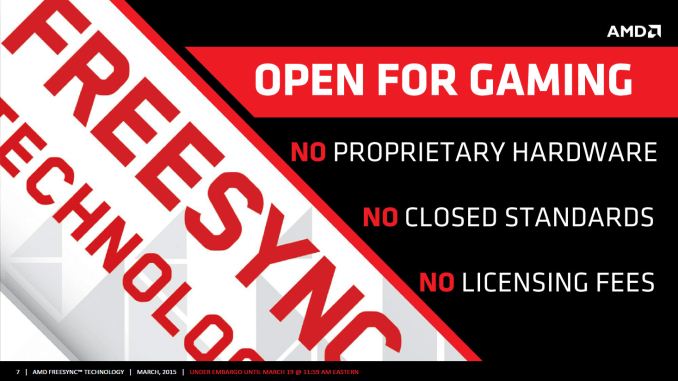The AMD FreeSync Review
by Jarred Walton on March 19, 2015 12:00 PM EST
Introduction to FreeSync and Adaptive Sync
The first time anyone talked about adaptive refresh rates for monitors – specifically applying the technique to gaming – was when NVIDIA demoed G-SYNC back in October 2013. The idea seemed so logical that I had to wonder why no one had tried to do it before. Certainly there are hurdles to overcome, e.g. what to do when the frame rate is too low, or too high; getting a panel that can handle adaptive refresh rates; supporting the feature in the graphics drivers. Still, it was an idea that made a lot of sense.
The impetus behind adaptive refresh is to overcome visual artifacts and stutter cause by the normal way of updating the screen. Briefly, the display is updated with new content from the graphics card at set intervals, typically 60 times per second. While that’s fine for normal applications, when it comes to games there are often cases where a new frame isn’t ready in time, causing a stall or stutter in rendering. Alternatively, the screen can be updated as soon as a new frame is ready, but that often results in tearing – where one part of the screen has the previous frame on top and the bottom part has the next frame (or frames in some cases).
Neither input lag/stutter nor image tearing are desirable, so NVIDIA set about creating a solution: G-SYNC. Perhaps the most difficult aspect for NVIDIA wasn’t creating the core technology but rather getting display partners to create and sell what would ultimately be a niche product – G-SYNC requires an NVIDIA GPU, so that rules out a large chunk of the market. Not surprisingly, the result was that G-SYNC took a bit of time to reach the market as a mature solution, with the first displays that supported the feature requiring modification by the end user.
Over the past year we’ve seen more G-SYNC displays ship that no longer require user modification, which is great, but pricing of the displays so far has been quite high. At present the least expensive G-SYNC displays are 1080p144 models that start at $450; similar displays without G-SYNC cost about $200 less. Higher spec displays like the 1440p144 ASUS ROG Swift cost $759 compared to other WQHD displays (albeit not 120/144Hz capable) that start at less than $400. And finally, 4Kp60 displays without G-SYNC cost $400-$500 whereas the 4Kp60 Acer XB280HK will set you back $750.
When AMD demonstrated their alternative adaptive refresh rate technology and cleverly called it FreeSync, it was a clear jab at the added cost of G-SYNC displays. As with G-SYNC, it has taken some time from the initial announcement to actual shipping hardware, but AMD has worked with the VESA group to implement FreeSync as an open standard that’s now part of DisplayPort 1.2a, and they aren’t getting any royalties from the technology. That’s the “Free” part of FreeSync, and while it doesn’t necessarily guarantee that FreeSync enabled displays will cost the same as non-FreeSync displays, the initial pricing looks quite promising.
There may be some additional costs associated with making a FreeSync display, though mostly these costs come in the way of using higher quality components. The major scaler companies – Realtek, Novatek, and MStar – have all built FreeSync (DisplayPort Adaptive Sync) into their latest products, and since most displays require a scaler anyway there’s no significant price increase. But if you compare a FreeSync 1440p144 display to a “normal” 1440p60 display of similar quality, the support for higher refresh rates inherently increases the price. So let’s look at what’s officially announced right now before we continue.













350 Comments
View All Comments
JarredWalton - Thursday, March 19, 2015 - link
Try counting again: LG 29", LG 34", BenQ 27", Acer 27" -- that's four. Thanks for playing. And the Samsung displays are announced and coming out later this month or early next. For NVIDIA, there are six displays available, and one coming next month (though I guess it's available overseas). I'm not aware of additional G-SYNC displays that have been announced, so there's our six/seven. I guess maybe we can count the early moddable LCDs from ASUS (and BenQ?) and call it 8/9 if you really want to stretch things.I'm not saying G-SYNC is bad, but the proprietary nature and price are definitely not benefits for the consumer. FreeSync may not be technically superior in every way (or at least, the individual implementations in each LCD may not be as good), but open and less expensive frequently wins out over closed and more expensive.
chizow - Friday, March 20, 2015 - link
@Jarred, thanks for playing, but you're still wrong. There's 8 G-Sync panels on the market, and even adding the 1 for AMD that's still double, so how that is "nearly caught up" is certainly an interesting lens.Nvidia also has panels in the works, including 2 new, major breakthroughs like the Acer 1440p IPS, 1st 144Hz, 1440p, IPS VRR panel and the Asus ROG Swift 4K IPS, 1st 4K IPS VRR monitor. So yes, while AMD is busy "almost catching up" with low end panels, Nvidia and their partners are continuing to pioneer the tech.
As for FreeSync bringing up the low end, I personally think it would be great if Nvidia adopted AdaptiveSync for their low end solutions and continued to support G-Sync as their premium solution. It would be great for the overwhelming majority of the market that owns Nvidia already, and would be one less reason for anyone to buy a Radeon card.
TheJian - Sunday, March 22, 2015 - link
You sure have a lot of excuses. This is beta 1.0, it's the lcd's fault (pcper didn't think so), assumption that open/free (this isn't free, $50 by your own account for freesync, which is the same as $40-60 for the gsync module right?, you even admit they're hiking prices at the vendor side for $100+) is frequently the winner. Ummm, tell that to CUDA and NV's generally more expensive cards. There is a reason they have pricing power (the are better), and own 70% discrete and ~75% workstation market. I digress...anubis44 - Tuesday, March 24, 2015 - link
@chizow:"I'll bet on the market leader that holds a commanding share of the dGPU market, consistently provides the best graphics cards, great support and features, and isn't riddled with billions in debt with a gloomy financial outlook."
You mean you'll bet on the crooked, corrupt, anti-competitive, money-grubbing company that doesn't compensate their customers when they rip them off (bumpgate), and has no qualms about selling them a bill of goods (GTX970 has 4GB ram! Well, 3.5GB of 'normal' speed ram, and .5GB of much slower, shitty ram.), likes to pay off game-makers to throw in trivial nVidia proprietary special effects (Batman franchise and PhysX, I'm looking right at you)? That company? Ok, you keep supporting the rip-off GPU maker, and see how this all ends for you.
chizow - Tuesday, March 24, 2015 - link
@Anubis44: Yeah again, I don't bother with any of that noise. The GTX 970 I bought for my wife in Dec had no adverse impact from the paper spec change made a few months ago, it is still the same fantastic value and perf it was the day it launched.But yes I am sure ignoramuses like yourself are quick to dismiss all the deceptive and downright deceitful things AMD has said in the past about FreeSync, now that we know its not really Free, can't be implemented with a firmware flash, does in fact require additional hardware, and doesn't even work with many of AMD's own GPUs. And how about CrossFireX? How long did AMD steal money from end-users like yourself on a solution that was flawed and broken for years on end, even denying there was a problem until Nvidia and the press exposed it with that entire runtframe FCAT fiasco?
And bumpgate? LMAO. AMD fanboys need to be careful who they point the finger at, especially in the case of AMD there's usually 4 more fingers pointed back at them. How about that Llano demand overstatement lawsuit still ongoing that specifically names most of AMD's exec board, including Read? How about that Apple extended warranty and class action lawsuit regarding the same package/bump issues on AMD's MacBook GPUs?
LOL its funny because idiots like you think "money-grubbing" is some pejorative and greedy companies are inherently evil, but then you look at AMD's financial woes and you understand they can only attract the kind of cheap, ignorant and obtusely stubborn customers LIKE YOU who won't even spend top dollar on their comparably low-end offerings. Then you wonder why AMD is always in a loss position, bleeding money from every orifice, saddled in debt. Because you're waiting for that R9 290 to have a MIR and drop from $208.42 to $199.97 before you crack that dusty wallet open and fork out your hard-earned money.
And when there is actually a problem with AMD product, you would rather make excuses for them and sweep those problems under the rug, rather than demand better product!
So yes, in the end, you and AMD deserve one another, for as long as it lasts anyways.
Yojimbo - Thursday, March 19, 2015 - link
HD-DVD was technically superior and higher cost? It seems BlueRay/HD-DVD is a counterexample to what you are saying, but you include it in the list to your favor. Laserdisc couldn't record whereas VCRs could. Minidisc was smaller and offered recording, but CD-R came soon after and then all it had was the smaller size. Finally MP3 players came along and did away with it.There's another difference in this instance, though, which doesn't apply to any of those situations that I am aware of, other than minidisc ): G-Sync/FreeSync are linked to an already installed user base of requisite products. (Minidisc was going up against CD libraries, although people could copy those. In any case, minidisc wasn't successful and was going AGAINST an installed user base.) NVIDIA has a dominant position in the installed GPU base, which is probably exactly the reason that NVIDIA chose to close off G-Sync and the "free" ended up being in FreeSync.
Assuming variable refresh catches on, if after some time G-Sync monitors are still significantly more expensive than FreeSync ones, it could become a problem for NVIDIA and they may have to either work to reduce the price or support FreeSync.
chizow - Thursday, March 19, 2015 - link
Uh, HD-DVD was the open standard there guy, and it lost to the proprietary one: Blu-Ray. But there's plenty of other instances of proprietary winning out and dominating, let's not forget Windows vs. Linux, DX vs. OpenGL, CUDA vs. OpenCL, list goes on and on.Fact remains, people will pay more for the better product, and better means better results, better support. I think Nvidia has shown time and again, that's where it beats AMD, and their customers are willing to pay more for it.
See: Broken Day 15 CF FreeSync drivers as exhibit A.
at80eighty - Thursday, March 19, 2015 - link
Keep paddling away, son. The ship isn't sinking at allchizow - Thursday, March 19, 2015 - link
If you buy a FreeSync monitor you will get 2-3 paddles for every 1 on a G-Sync panel. That will certainly help you pedal faster.http://www.pcper.com/image/view/54234?return=node%...
at80eighty - Friday, March 20, 2015 - link
oh hey great example - no ghosting there at all. brilliant!